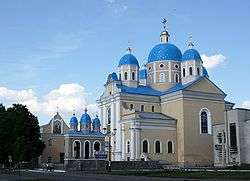Chervonohrad
| Chervonohrad | |||
|---|---|---|---|
| City of regional significance | |||
| Червоноград | |||
| |||
 Chervonohrad Location of Chervonohrad in Ukraine | |||
| Coordinates: 50°23′N 24°14′E / 50.39°N 24.23°ECoordinates: 50°23′N 24°14′E / 50.39°N 24.23°E | |||
| Country |
| ||
| Oblast |
| ||
| Municipality | Chervonohrad | ||
| Founded | 1692 | ||
| Government | |||
| • Mayor | Serhiy Chudovskiy | ||
| Area | |||
| • Total | 37.6 km2 (14.5 sq mi) | ||
| Elevation | 150 m (490 ft) | ||
| Population (2016) | |||
| • Total | 67,492 | ||
| Time zone | EET (UTC+2) | ||
| • Summer (DST) | EEST (UTC+3) | ||
| Sister cities | Békéscsaba | ||
Chervonohrad (Ukrainian: Червоноград, Polish: Czerwonogród) is a mining city located in the Lviv Oblast of western Ukraine. Chervonohrad is designated as a city of oblast significance. It about 62 km north of Lviv, 7 km from Sokal, and 28 km northeast of the town of Voroniv. Population: 67,492 (2016 est.)[1].
Prior to 1 November 1951, the city was known as Krystynopil (Ukrainian: Кристинопіль, translit. Krystynopil'). The German name for it was Krisnipolye. The city is known for mining that started in the 1950s. It passed from Poland to the USSR after the territory exchange in 1951. Local Ukrainians also frequently refer to the city as "Krasnohrad," literally meaning red city in the Russian language.
The municipality of Chervonohrad also includes the town of Sosnivka and the urban type settlement of Hirnyk.
History
In May 1685 the royal hetman, Kraków Voivode Feliks Kazimierz Potocki, bought himself a new piece of land on the Bug River. In 1692, he founded a city on the lands of the village "Novyi Dvir" (literally "New Garden", Polish: Nowy Dwór), which he named after his wife Krystyna Lubomirski (1661–1699). Potocki made Krystonopil' his family center. He died here on September 22, 1702. His grandson Franciszek Salezy Potocki built a palace and in 1763 founded a monastery of Basilians (barocco church of Saint George; prior to 1946 р. - miracle place with wonder icon of the Mother of God).

In the 19th century, the "Apostolus Christinopolitanus" and a famous chronicle from 1763–1779, were kept in this city.
The Catholic order of Myrrh-Bearing Sisters were founded in 1910 in Chervonohrad (then Krystynopil') by Fr. Yulian Datsii. The congregation was founded to gather funds to build a home for orphans and the poor. The first members of the congregation vowed to build two buildings: one for the people, and one for the congregation. In 1913 the first convent arose, where 15 sisters lived.
Among the landmarks of the city is Count Potocki's palace, constructed by the order of Feliks Kazimierz Potocki after 1692.
On August 1, 1990, Chervonohrad became the first city in the whole Soviet Union, where a monument to Communist leader Vladimir Lenin was removed.
Krystynopil' Jews
Presently there are 11-100 Jews residing in Chervonohrad. The earliest known Jewish community dates back to 1740. In 1931 the Jewish population was 2200. The Jewish cemetery dates from 18th century with the last known Hasidic burial in 1941. Chervonohrad Jews were deported to the Belzec extermination camp in September, 1942. The Jewish surname and rabbinical family Kristinopoler / Kristianpoller stem from the city's former name, Krystynopil'. Jewish immigrants to America from this city founded the Krystenopoler Synagogue and First Krystenopoler Sick Benevolent Association Brith Isaac in New York. The Jewish cemetery is located in the town center, at Shevs'ka Street.
Economics

Since 1951 the city became the center of newly emerged coal mining basin. Other enterprises, besides the mining works, include:
- Iron-Beton Foundry
- Wood Processing Plant
- Tailoring Factory
- Stockings Factory
- Mines
- Dairy
Chervonohrad Coal Mines
Chervonohrad was started as a coal mining town. Currently, there are still many functional coal mines in the outskirts around the city:
- 1) Шахта «Червоноградська»
- 2) Шахта «Великомостівська»
- 3) Шахта «Межирічанська»
- 4) Шахта «Надія»
- 5) Шахта «Степова»
- 6) Шахта «Лісова»
- 7) Шахта «Відродження»
- 8) Шахта «Зарічна»
- 9) Шахта «Візейська»
Education
- Branch of Lviv National Polytechnic University
- Mining College
Population
The population of Chervonohrad has increased significantly since 1939.
- 1939 — 3,000
- 1959 — 19,000
- 1970 — 54,000
- 1974 — 61,000
- 1981 — 78,000
- 1989 — 89,000
- 2001 — 85,500
- 2005 — 83,400
- 2010 — 82,900[2][3]
- 2013 — 83,600
Postal codes
80100-80110
References
- ↑ "Чисельність наявного населення України (Actual population of Ukraine)" (PDF) (in Ukrainian). State Statistics Service of Ukraine. Retrieved 19 July 2016.
- ↑ "Archived copy". Archived from the original on 2012-05-06. Retrieved 2010-12-01.
- ↑ http://populstat.info/Europe/ukrainet.htm
External links
| Wikimedia Commons has media related to Chervonograd. |
- TAXI CHERVONOGRAD
- An extensive history of Jewish Krystynopol
- History and pictures of Chervonograd
- Short history of Rome Catholic Church in Cherwonograd (Krystynopil)
- Holy Spirit Roman Catholic Church in Chervonograd
- Chervonohrad Online
- Business of Chervonohrad

